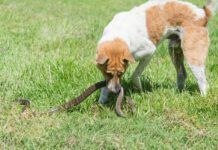I have two nine-month-old puppies, brothers from the same litter, who have received all the usually recommended vaccinations, on exactly the same schedules (I have taken them to the veterinarians at the same time for all their maintenance visits). Recently, after being boarded at a large facility, one of them began to exhibit symptoms of parvovirus. After receiving IV fluids and antibiotics, he recovered, but I am shaken up. Why should a well-vaccinated puppy contract the disease? And why should my other pup, who has been exposed to all the same things, be fine?
And here is another puzzle. After hearing that one of my puppies had gotten parvovirus, my next-door neighbor began to worry about her six-month-old puppy, who often plays with my dogs. Her puppy has had all of her shots, and my neighbor didn’t want to revaccinate unless it was necessary, so she had a titer test run on the puppy. The test revealed that the puppy no immunity to parvovirus at all, so she had the pup revaccinated immediately. What is going on here? Is it possible that my puppy was infected with a new strain of parvovirus, one that his vaccinations didn’t protect him from?
-Name withheld by request
Charlotte, North Carolina
We turned this question over to W. Jean Dodds, DVM, a long-time expert in veterinary hematology and immunology. She is also the founder and President of Hemopet/Pet Life-Line, a non-profit, national, animal blood bank and adoption program for retired greyhounds. Dr. Dodds lives in Santa Monica, CA.
First of all, you need to understand that it doesn’t matter how well an animal has been vaccinated. No vaccine produces 100 percent protection, 100 percent of the time. There will always be an occasional case of a “vaccine break,” which is what we call it when a vaccine fails to protect an individual against an infectious disease challenge. However, when a break occurs, if the animal has been appropriately vaccinated, it will usually experience only a mild form of the disease. This is the most probable explanation for what happened with your puppy.
While there are some rare exceptions – where an appropriately vaccinated animal nonetheless experiences a lethal form of the disease – it is far more typical that such an animal will experience only a mild form of the disease and will recover quickly.
Vaccination is not a sure thing. It certainly improves the odds that an animal will be protected from disease, but it does not guarantee this. There is no way, even with the best vaccines, to be sure that any given individual’s immune system will respond in the desired way to protect that animal.
However, I’d like you to consider some other possible explanations for what happened to your puppy:
A puppy could contract parvovirus, even after receiving several vaccinations intended to convey protection from the disease, if the antibodies received from the mother’s colostrum and, to a lesser extent in utero, interfered with proper immunization by neutralizing the vaccine’s effect. Most puppy vaccine failures are caused by this interference from maternal antibodies. If a puppy receives a particularly high level of antibodies (passive immunity) from its mother, the vaccine antigens are neutralized, so that when these antibodies wane, the puppy is left without adequate protection, and has failed to become actively immunized.
When puppies are first born, they are protected from infectious disease antigens by maternal antibodies. This is followed by a period when the puppies are partially susceptible to contracting a disease, because the maternal antibody levels are waning but are still high enough to partially inactivate the vaccine antigens. And, finally, comes the time when the maternal antibodies are low enough to permit the vaccine to take over fully and produce good, active immunization. Maternal antibodies wane at a somewhat unpredictable rate, which is why puppies are vaccinated several times at intervals of two to four weeks apart. This is an effort to cover any potential gap in protection or “window of susceptibility” that arises from the waning of maternal passive immunity and the onset of active immunization and protection by vaccination.
May not have been parvo
Another possible explanation for your puppy’s symptoms is that it had some disease other than parvovirus, despite your veterinarian’s diagnosis.
Veterinarians diagnose parvovirus disease by its symptoms – fever, depression, diarrhea, vomiting – AND by checking the dog’s stool for presence of the virus or serum antibody level. But there are other gastrointestinal diseases that produce symptoms that closely resemble those of parvovirus, and even the presence of low levels of parvovirus in the stool doesn’t necessarily mean that the dog’s symptoms are caused by it.
Dogs that are vaccinated and fully protected against parvovirus may still shed parvovirus in their stool if they are exposed to the disease agent. Unless the stool sample revealed a moderate to heavy parvovirus infection, the dog’s symptoms could be caused by something else, or a combination of parvovirus exposure and another infectious agent. For example, the puppy could have been exposed to both parvovirus and corona virus, and then suffer diarrhea and other symptoms as a result of the corona virus alone, because he was adequately protected by vaccination against parvovirus.
Trouble with titers
Regarding your neighbor’s puppy: Chances are very good that the puppy may have had adequate protection from parvovirus, despite the titer test results. Here is why:
There are two types of titer tests commonly offered by most veterinary medical laboratories. One type is intended to detect whether or not a dog has the disease (viral infection); the other type of titer test checks the level of immunity the dog received from vaccination. In the latter case (vaccine titer test), antibody levels are expected to be several titer dilutions lower than those conveyed by active viral infection. If your neighbor’s veterinarian requested an immunity or antibody level measurement for parvovirus or other disease, the laboratory typically assumes that disease diagnosis, rather than vaccine immunity, is to be performed. When the lab technicians do a test to see whether the dog has parvovirus, they start the dilution in the test system much higher than you would normally see from vaccination (to conserve reagent and reduce cost of testing). As vaccine titers are lower; they won’t be detected unless the test reagent dilution is set lower as seen with vaccine titers as opposed to disease titers. I’ll put it a different way: If they utilize disease exposure methodology, when what is really wanted is a test to assess the adequacy of vaccination, it will be negative nearly every time.
It sounds like an obvious oversight, but I’ve seen it again and again in cases where I serve as a consultant. The owner calls me and says, “But I keep vaccinating this animal, and my veterinarian keeps testing him and there is no immunity; what do I do?!” Very often, it’s a case where the veterinarian looked at the lab catalog, and then selected the test called “Parvovirus Antibody” rather than the intended one, which would be “Parvovirus Vaccine Antibody” or “Parvovirus Vaccine Titer.” Meanwhile, the poor animal has been vaccinated repeatedly, and when we finally get the correct measurement, it’s actually had good immunity all along.
Finally, regarding your question about viral strains: For a long time, researchers have known that outbreaks of infectious diseases, like parvovirus, can be caused by different strains as viruses mutate so quickly. Some infectious agents (e.g. influenza virus) change enough over time that you have to make a new vaccine strain to protect the population, whereas others change their outer coat without much change in the central core of the organism. Parvovirus, happily, falls in this latter category. Research has shown that even when parvovirus mutates, it has the same core, and so the current, more potent vaccines still protect against the newer forms of parvovirus.





